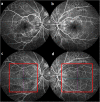Optical coherence tomography angiography in diabetic retinopathy: a review of current applications
- PMID: 31832448
- PMCID: PMC6859616
- DOI: 10.1186/s40662-019-0160-3
Optical coherence tomography angiography in diabetic retinopathy: a review of current applications
Abstract
Background: Diabetic retinopathy (DR) is a leading cause of vision loss in adults. Currently, the standard imaging technique to monitor and prognosticate DR and diabetic maculopathy is dye-based angiography. With the introduction of optical coherence tomography angiography (OCTA), it may serve as a potential rapid, non-invasive imaging modality as an adjunct.
Main text: Recent studies on the role of OCTA in DR include the use of vascular parameters e.g., vessel density, intercapillary spacing, vessel diameter index, length of vessels based on skeletonised OCTA, the total length of vessels, vascular architecture and area of the foveal avascular zone. These quantitative measures may be able to detect changes with the severity and progress of DR for clinical research. OCTA may also serve as a non-invasive imaging method to detect diabetic macula ischemia, which may help predict visual prognosis. However, there are many limitations of OCTA in DR, such as difficulty in segmentation between superficial and deep capillary plexus; and its use in diabetic macula edema where the presence of cystic spaces may affect image results. Future applications of OCTA in the anterior segment include detection of anterior segment ischemia and iris neovascularisation associated with proliferative DR and risk of neovascular glaucoma.
Conclusion: OCTA may potentially serve as a useful non-invasive imaging tool in the diagnosis and monitoring of diabetic retinopathy and maculopathy in the future. Future studies may demonstrate how quantitative OCTA measures may have a role in detecting early retinal changes in patients with diabetes.
Keywords: Diabetic retinopathy; Fluorescein angiography; Monitoring; Optical coherence tomography angiography; Screening.
© The Author(s). 2019.
Conflict of interest statement
Competing interestsThe authors declare that they have no competing interests.
Figures



References
-
- World Health Organisation. Global report on diabates. Geneva: World Health Organisation; 2016.
Publication types
LinkOut - more resources
Full Text Sources

